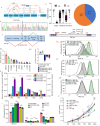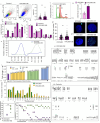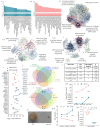A novel ITGB8 transcript variant sustains ovarian cancer cell survival through genomic instability and altered ploidy on a mutant p53 background
- PMID: 39506768
- PMCID: PMC11539462
- DOI: 10.1186/s13048-024-01538-6
A novel ITGB8 transcript variant sustains ovarian cancer cell survival through genomic instability and altered ploidy on a mutant p53 background
Abstract
Background: Transcript variants and protein isoforms are central to unique tissue functions and maintenance of homeostasis, in addition to being associated with aberrant states such as cancer, where their crosstalk with the mutated tumor suppressor p53 may contribute to genomic instability and chromosomal rearrangements. We previously identified several novel splice variants in ovarian cancer RNA-sequencing datasets; herein, we aimed to elucidate the biological effects of the Integrin Subunit Beta 8 variant (termed pITGB8-205).
Methods: Resolution of the full-length sequence of pITGB8-205 through rapid amplification of cDNA ends (RACE-PCR). Cell cycle analysis and karyotype studies were performed to further explore genomic instability. RNA-seq and proteomics analyses were used to identify the differential expression of the genes.
Results: This full-length study revealed a unique 5' sequence in pITGB8-205 that differed from the reported ITGB8-205 sequence, suggesting differential regulation of this novel transcript. Under a p53 mutant background, overexpression of pITGB8-205 triggered genetic instability reminiscent of oncogene-induced replicative stress with extensive abnormal mitoses and chromosomal and nuclear aberrations indicative of chromosomal instability, leading to near whole-genome duplication that imposes energy stress on cellular resources. Micronuclei and aneuploidy are striking features of pITGB8-205-overexpressing p53-mutant cells but are not enhanced in p53 wild-type (WT) cells. RNA-seq and proteomics analyses further suggested that p53 inactivation in ovarian cancer provides a permissive intracellular molecular niche for pITGB8-205 to mediate its effects on genomic instability. This observation is pivotal considering that most high-grade serous ovarian carcinoma (HGSC) tumors express mutant p53. The resulting aneuploid clones with enhanced self-renewal and survival capabilities disrupt clonal dominance under stress yet maintain a balance between replicative stress and prosurvival advantages.
Conclusion: pITGB8-205-overexpressing clones sustain ovarian tumor cell survival, achieve homeostasis and are formidable opponents of therapy.
Keywords: Aneuploidy; Genomic instability; ITGB8; Prosurvival mechanisms; p53.
© 2024. The Author(s).
Figures




Similar articles
-
TP53 mutation-mediated genomic instability induces the evolution of chemoresistance and recurrence in epithelial ovarian cancer.Diagn Pathol. 2017 Feb 2;12(1):16. doi: 10.1186/s13000-017-0605-8. Diagn Pathol. 2017. PMID: 28148293 Free PMC article.
-
Integrin Subunit beta 8 (ITGB8) Upregulation Is an Independent Predictor of Unfavorable Survival of High-Grade Serous Ovarian Carcinoma Patients.Med Sci Monit. 2018 Dec 10;24:8933-8940. doi: 10.12659/MSM.911518. Med Sci Monit. 2018. PMID: 30531684 Free PMC article.
-
Targeted Genomic Sequencing Reveals Novel TP53 In-frame Deletion Mutations Leading to p53 Overexpression in High-grade Serous Tubo-ovarian Carcinoma.Anticancer Res. 2019 Jun;39(6):2883-2889. doi: 10.21873/anticanres.13417. Anticancer Res. 2019. PMID: 31177126
-
Links between mutant p53 and genomic instability.J Cell Biochem. 2012 Feb;113(2):433-9. doi: 10.1002/jcb.23400. J Cell Biochem. 2012. PMID: 22006292 Free PMC article. Review.
-
Sequential molecular changes and dynamic oxidative stress in high-grade serous ovarian carcinogenesis.Free Radic Res. 2017 Oct;51(9-10):755-764. doi: 10.1080/10715762.2017.1383605. Epub 2017 Oct 11. Free Radic Res. 2017. PMID: 28931330 Review.
References
-
- Da Costa PJ, Menezes J, Romão L. The role of alternative splicing coupled to nonsense-mediated mRNA decay in human disease. Int J Biochem Cell Biol. 2017;91:168–75. - PubMed
MeSH terms
Substances
Grants and funding
LinkOut - more resources
Full Text Sources
Medical
Research Materials
Miscellaneous

